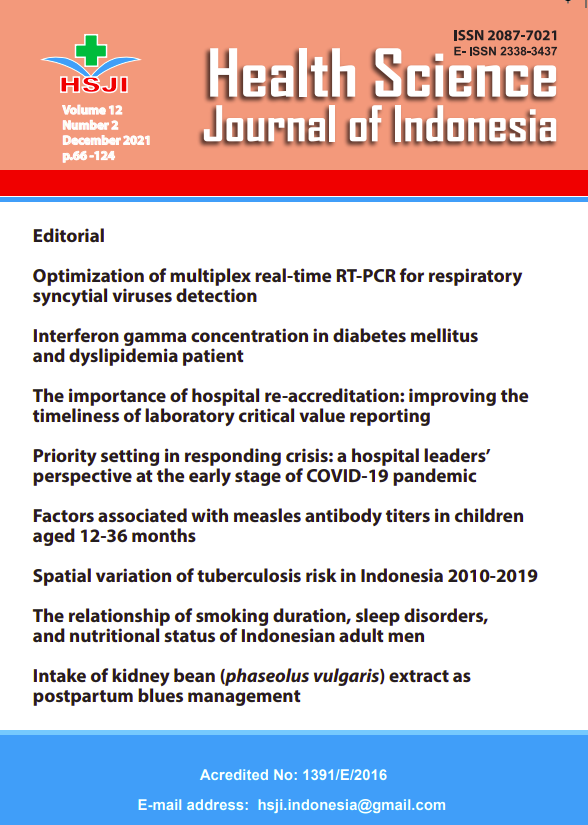The importance of hospital re-accreditation: improving the timeliness of laboratory critical value reporting
Abstract
Background: Patient safety is the main issue in healthcare services nowadays. Delaying to inform the critical value of laboratory results is a significant source of harm for the patient. The aim of this study is to compare the timeliness of laboratory critical value reporting before and after re-accreditation as one of the service quality indicators in Hospital X.
Methods: This study was done by using observational cross-sectional in Hospital X on January - February 2020 with total sampling method of critical value reporting to the responsible clinician that originated from Intensive Care Unit (ICU), Verlos Kamer (VK), and inpatient ward (IW) 1-6 from January-December 2019. The timeliness of reporting was counted since the laboratory result was obtained until received by the responsible clinician within £ 30 minutes and categorized as "On time" or "Late".
Results: During 2019, there were 816 reporting which has been done before re-accreditation (511) and after re-accreditation (305) with 17 kinds of tests. The most reported test was platelet with 349 (before re-accreditation) and 101 (after re-accreditation), whilst SGOT/SGPT and albumin were the fewest one. The lowest timeliness of reporting percentage was 76,00% (February), whilst the highest was 98,48% (November). The timeliness of reporting's percentage was 84,34% (before re-accreditation) and 94,43% (after re-accreditation). The statistical analysis result revealed Pearson Chi-Square correlation was 18,535 with significance 0,000 and 3,145 odds ratio which shows that re-accreditation could significantly increase the timeliness of critical value reporting three times.
Conclusion: This result showed that re-accreditation could affect the timeliness of laboratory critical value reporting to the responsible clinicians.
Keywords: re-accreditation, critical value, laboratory, patient safety, hospital
Abstrak
Latar belakang: Keselamatan pasien merupakan isu utama dalam pelayanan kesehatan. Tertundanya komunikasi hasil nilai kritis laboratorium merupakan sumber bahaya yang signifikan terhadap pasien. Penelitian ini bertujuan untuk membandingkan ketepatan waktu pelaporan nilai kritis laboratorium sebelum dan setelah reakreditasi sebagai salah satu indikator mutu di RS X.
Metode: Penelitian dilakukan dengan cara observasional dengan metode cross sectional di RS X pada Januari - Februari 2020 dengan total sampling laporan nilai kritis kepada Dokter Penanggung Jawab Pasien (DPJP) yang berasal dari ruang Intensive Care Unit (ICU), Verlos Kamer (VK), dan ruang rawat inap 1 – 6 sejak Januari – Desember 2019. Ketepatan waktu pelaporan dihitung sejak hasil pemeriksaan didapatkan hingga diterima oleh DPJP dalam waktu £ 30 menit dan dinyatakan sebagai "Tepat Waktu" atau "Terlambat".
Hasil: Selama tahun 2019, terdapat 816 pelaporan yang dilakukan sebelum akreditasi (511) dan setelahnya (305) dengan 17 jenis pemeriksaan. Pemeriksaan trombosit menjadi yang paling banyak dilaporkan yaitu 349 (sebelum akreditasi) dan 101 (setelah akreditasi), sedangkan SGOT/SGPT dan albumin menjadi yang paling sedikit. Persentase ketepatan waktu pelaporan paling rendah adalah 76,00% (Februari) sedangkan yang paling tinggi adalah 98,48% (November). Persentase ketepatan waktu pelaporan didapatkan 84,34% (sebelum akreditasi) dan 94,43% (setelah akreditasi). Hasil analisis statistik didapatkan korelasi Pearson Chi-Square 18,535 dengan signifikansi 0,000 dan Odds ratio 3,145 menunjukkan re-akreditasi mampu meningkatkan kemungkinan ketepatan waktu pelaporan nilai kritis sebesar tiga kali lipat.
Kesimpulan: Hal ini menunjukkan bahwa re-akreditasi mampu mempengaruhi ketepatan waktu pelaporan nilai laboratorium kritis kepada DPJP.
Kata kunci: re-akreditasi, nilai kritis, laboratorium, keselamatan pasien, rumah sakit.

